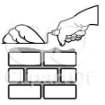In this one-year course students work with brick and block on full-sized projects in the lab, on campus and at construction sites. Students learn to use, care for and safely handle the tools, machinery, equipment and materials commonly used in the masonry trade. Activities involve laying brick, building walls and columns and planning and constructing a variety of structures. The masonry program also includes working with stone, concrete and interlock paving.
Virginia Beach City Public Schools ensures equal access to all CTE courses. Accessibility accommodations will be provided as needed.
|
Masonry I |
|||||
|
Unit |
The Nature of Technology  |
Masonry Technology and Society  |
Design and Engineering in Masonry  |
Applying Design Processes in Masonry  |
Select and Apply Technology in Masonry  |
|
Focus |
Technology is a varied field of study. Students will examine the definition and applications of masonry. |
Technology has a strong influence on society. Students will understand and describe the impacts of masonry. |
Resources are the raw materials of a technological system. Selecting and applying them toward a construction solution is essential. |
Technology is a tool to assist in solving complex construction problems. A systems approach is a framework to design solutions. |
The role of technology is diverse. Identifying the role of technology in construction is essential to an improved understanding. |
|
Transfer Goals |
|
|
|
|
|
|
Unit Learning Targets |
|
|
|
|
|
